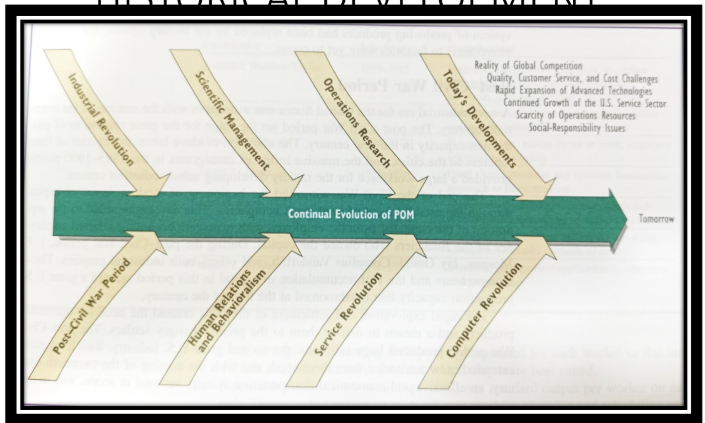Historical Development
1. The Industrial Revolution (1760s-1840s):
- Cottage System: Prior to the Industrial Revolution, production was primarily decentralized and carried out in homes by craftsmen and their apprentices (cottage system).
- Introduction of Machines and Factories: The invention of steam engines and other machinery led to the establishment of factories, where large numbers of workers were concentrated to produce goods on a mass scale.
- Division of Labor: Adam Smith's "The Wealth of Nations" emphasized the benefits of dividing labor into smaller, specialized tasks, leading to increased efficiency and productivity.
- Interchangeable Parts: Eli Whitney's concept of interchangeable parts revolutionized manufacturing, making it easier to assemble and repair products.
- Textile Industry: The textile industry was one of the first to embrace the Industrial Revolution, with inventions like the spinning jenny and the power loom significantly increasing production.
2. Post-Civil War Period (1865-1914):
- New Industrial Era: The end of slavery and the influx of immigrants fueled a new era of industrial growth in the United States.
- Rise of Large Corporations: Joint stock companies emerged, separating ownership from management and leading to the formation of large industrial empires.
- Transportation Revolution: The development of railroads significantly improved transportation, connecting different regions and facilitating the movement of goods and raw materials.
3. Scientific Management (1900s-1920s):
- Focus on Efficiency: Frederick Taylor introduced scientific management principles to optimize production processes and reduce waste.
- Time and Motion Studies: Taylor conducted detailed studies to analyze the movements and time required for each task, leading to the development of standardized work methods.
- Incentive Systems: He implemented incentive systems to reward workers for exceeding production quotas, further boosting efficiency.
- Assembly Line Production: The assembly line, pioneered by Henry Ford, revolutionized mass production, enabling the efficient production of large quantities of goods.
4. Human Relations and Behavioralism (1930s-1950s):
- Hawthorne Studies: The Hawthorne studies, conducted at Western Electric's Hawthorne plant, demonstrated the importance of human factors in productivity.
- Psychological and Social Factors: Researchers found that factors such as employee morale, motivation, and social interaction significantly influenced productivity.
- Behavioral Theories: Management theorists like Chester Barnard, Abraham Maslow, Frederick Herzberg, Douglas McGregor, and Peter Drucker contributed to the development of behavioral theories, emphasizing the importance of understanding human behavior in the workplace.
5. Operations Research (1940s-1960s):
- World War II: The demands of World War II led to the development of operations research (OR), a quantitative approach to decision-making.
- Complex Decision-Making: OR uses mathematical and statistical techniques to analyze complex problems and identify optimal solutions.
- Total Systems Approach: OR emphasizes a holistic view of the system, considering all relevant factors and their interactions.
- Computerization: The advent of computers significantly enhanced the capabilities of OR, enabling the analysis of large and complex data sets.
6. The Service Revolution (1970s-present):
- Shift from Manufacturing to Services: As economies developed, there was a shift from manufacturing to service industries, such as healthcare, finance, and transportation.
- Focus on Customer Satisfaction: Service organizations prioritize customer satisfaction and quality of service.
- Technology-Driven Innovation: The rise of information and communication technologies has revolutionized the service sector, enabling faster and more efficient delivery of services.
7. The Computer Revolution (1980s-present):
- Integration of Information Systems: The widespread adoption of computers and information systems has enabled organizations to collect, store, and analyze vast amounts of data.
- Real-Time Decision-Making: Enterprise Resource Planning (ERP) systems provide real-time information about inventory levels, customer orders, and other critical data, enabling managers to make informed decisions quickly.
- Global Operations: Advances in communication technologies have facilitated global operations, allowing organizations to collaborate with teams and suppliers across different time zones and locations.
- Lean Manufacturing: Techniques like lean manufacturing and just-in-time (JIT) inventory management have improved efficiency and reduced waste in manufacturing and service operations.
Key Developments in Modern Operations Management:
- Total Quality Management (TQM): A management approach focused on continuous improvement of quality, customer satisfaction, and employee involvement.
- Supply Chain Management (SCM): The coordination and management of all activities involved in the procurement, production, and distribution of goods and services.
- Business Process Reengineering (BPR): A radical redesign of business processes to improve efficiency, effectiveness, and customer value.
- Outsourcing: The contracting out of non-core business activities to third-party suppliers.
- Virtual Organizations: Networks of interconnected organizations that collaborate to achieve common goals.


No Comments